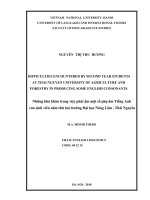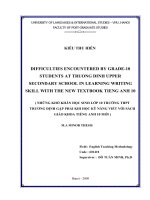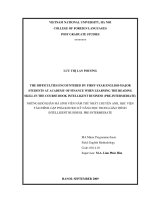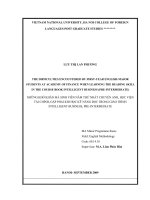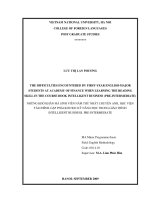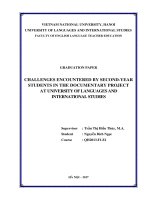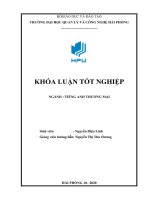difficulties encountered by 3rd year students at tlu majoring in english linguistics when writing ielts task 2
Bạn đang xem bản rút gọn của tài liệu. Xem và tải ngay bản đầy đủ của tài liệu tại đây (521.94 KB, 22 trang )
<span class="text_page_counter">Trang 1</span><div class="page_container" data-page="1">
<b>THANG LONG UNIVERSITYENGLISH DEPARTMENT</b>
<b>END-OF-TERM PAPER</b>
<b>DIFFICULTIES ENCOUNTERED BY 3RD-YEARSTUDENTS AT TLU MAJORING IN ENGLISHLINGUISTICS WHEN WRITING IELTS TASK 2 </b>
<b>Student’s name: Nguyễn Thị Diễm Quỳnh Student’s code: A39815</b>
<b> Major: English Linguistics Subject: Research Methodology Instructor: Ms. Nguyễn Thị Hải Bình</b>
<b>Hanoi, January 16</b>
</div><span class="text_page_counter">Trang 2</span><div class="page_container" data-page="2">IELTS is popular in Vietnam thanks to its reliability and applicability. Writing task 2 has been acknowledged to be the most challenging for IELTS learners. Surprisingly, in Vietnam, not much research has attempted to investigate in an in-depth manner as to what are the problems, causes, and consequently the suggestions of such a notion. Hence, The research aims to investigate the phenomenon more thoroughly and
comprehensively. To this end, the study will employ the participation of 30 juniors majoring in English Linguistics at TLU to provide their opinions through a questionnaire regarding the problems and causes when they embark on writing task 2 in IELTS. The research was quantitative in nature, producing numerical data as a result. The results suggested that TLU’s juniors would face four main problems with IELTS Writing Test 2: shortage of social knowledge, lack of time management skills, limitations in vocabulary and grammar, and struggle to organize ideas. The study suggests students should read more academic articles or documents to broaden their perspective, manage time wisely, find the appropriate IELTS materials to enhance students’ vocabulary and grammar, and seek feedback from a partner or IELTS instructor. The research thus served as the basis for IELTS learners when writing task 2 to identify the current issues and provide relatable approaches.
<b>Keywords</b>: IELTS Writing task 2, Writing difficulties, writing solutions, 3rd-year students, English Linguistics
</div><span class="text_page_counter">Trang 3</span><div class="page_container" data-page="3">1.5. Significance of the study
<b>CHAPTER II. LITERATURE REVIEW</b>
</div><span class="text_page_counter">Trang 4</span><div class="page_container" data-page="4"><b>LIST OF ABBREVIATION</b>
TLU: Thang Long University
IELTS: International English Language Testing System ESL: English as a Second Language
EFL: English as a Foreign Language CC: Coherence and Cohesion
</div><span class="text_page_counter">Trang 5</span><div class="page_container" data-page="5"><b>CHAPTER I. INTRODUCTION 1.1. Background of the study</b>
IELTS (International English Language Testing System) has been recognized as a reliable measure of English language
proficiency and is trusted by thousands of organizations worldwide for its “quality and integrity” (IELTS, 2021a). Given its “prestige” influence, a large number of learners of different first language backgrounds study it for their varied individual purposes (IELTS, 2021b). The IELTS “fever” has turned unprecedentedly acute now that it can be employed as a passport for admission into top universities in Vietnam (Phapluat, 2022; Vietnamnet, 2021).
Hence, IELTS is one of the high-level tests designed to assess the language proficiency of those who intend to pursue their academic study in native speaker countries. IELTS is divided into two types namely IELTS academic and IELTS general training. One of the English skills that one should be mastered is academic writing. The IELTS Writing test consists of two tasks, they are writing task 1 and writing task 2. In writing part 1, tastes must describe, summarise, or explain the information in a graph, table, chart, or diagram, while in writing task 2, they must write an essay in response to a point of view, argument, or problem. In writing task 2, tastes must bring in their thoughts, comments, and evaluation or answer a question (Silalahi, 2014). Therefore, writing task 2 seems more challenging because the test taker should gather the ideas to construct a good essay.
Besides, globalization is a booming trend, resulting in international corporations establishing branches in foreign countries (Kordos & Vojtovic, 2016). This is why employees in Vietnam are required to be able to communicate in English and IELTS is one of the examinations that can confirm this. As a result, it is sufficient to say that not only are students attracted to IELTS, but adults also find IELTS an irresistible opportunity to enhance their careers. Specifically, at TLU, IELTS 7.0 is the
</div><span class="text_page_counter">Trang 6</span><div class="page_container" data-page="6">prerequisite for those studying English Linguistics so as to graduate.
<b>1.2. Research problem</b>
Many test takers regard the writing skill test as a complex skill to learn and the most difficult part of the IELTS test (Mohamed, 2020). In line with the statement, Marashi argued that the writing section on IELTS was commonly considered one of the most difficult parts of the test (Marashi, 2021). The test takers cannot even understand what to do with the tasks provided. They eventually wrote without knowing the expected direction. For that reason, IELTS test takers need to practice their writing ability to comprehend how to construct the idea and paragraph in the essay.
In 2022, the average band of the writing test of Vietnamese candidates was only 6.0 – lower than the listening and reading average score (VnEpress International, 2023). This suggests that IELTS test takers in Vietnam are struggling with the skill in general and Task 2 specifically, which explains why a great number of learners resort to IELTS centers to improve their writing skills. Learners' performance in Task 2, hence, leads to a low band in the overall band for writing skills, hindering their academic development and preventing them from achieving their desired goals, either in their studies or work. Furthermore, in Vietnam, IELTS is also one of the requirements for university or college graduation. This translates into heavy stress on Vietnamese students who have to attain the IELTS certificate so as to graduate. It is also worth noting that for people not majoring in English, the problem is even more exacerbated as they often find it difficult to construct sentences and
paragraphs which are fundamental in Task 2 (Tran, 2016).
<b>1.3. Research purposes</b>
Identify key challenges faced by Juniors at TLU when Writing Task 2 in the IELTS test
Find out the factors that affect writing performance Propose effective strategies and solutions to overcome these challenges.
<b>1.4. Research questions</b>
</div><span class="text_page_counter">Trang 7</span><div class="page_container" data-page="7">Aligned with the defined objective, three research questions are formulated to guide the investigation:
What are the specific challenges faced by Juniors at TLU when writing IELTS Writing Task 2?
What factors contribute to the difficulties experienced by learners in IELTS Writing Task 2?
What actionable suggestions can be proposed to address and resolve the challenges encountered by TLU’s third-year students in IELTS Writing Task 2?
By addressing these research questions, the study aims to illuminate the intricacies of the challenges posed by IELTS Task 2 and offer constructive insights to empower TLU’s students in navigating these complexities.
<b>1.5. Significance of the study</b>
There are currently plenty of articles and books addressing EFL learners’ writing skills and the IELTS writing test. However, studies on third-year students at TLU difficulties in IELTS WritingTask 2 are limited at best. With this research, TLU’s juniors problems can be identified in a detailed manner. Henceforth, this paper not only seeks to bring practical
measures to IELTS trainers at TLU but also to other universities and IELTS teachers can apply in their classrooms so that learners’ performance in Task 2 can be significantly enhanced overall.
<b>CHAPTER II. LITERATURE REVIEW2.1. Theoretical Framework</b>
A general view of the IELTS examination
IELTS stands for International English Language Testing System. The test provides a measurement of the English proficiency of an individual through a single test administered regardless of existing ability. The purpose of the test is usually to predict a test-taker’s readiness for study or residence in an English-speaking country (Coleman et al., 2003). The test comprises four modules, each representing the four macro skills: listening, reading, writing, and speaking. Performance is measured in bands from 1-9, with 9 representing the highest level of language ability.
Writing Skills
According to Alanazi (2017), regardless of one's initial language, writing is perceived as a challenging task. He also
</div><span class="text_page_counter">Trang 8</span><div class="page_container" data-page="8">acknowledges that becoming a competent writer involves making mistakes and errors. Nguyen (2021) states that writing is the process of conveying thoughts and ideas, widely
recognized as a challenging skill to attain proficiency in. Kwak (2017) suggests that learning to write involves explicitly acquiring the mechanics, correct usage, and standard features of academic writing. Finally, Behizadeh and Engelhard (2011) explain that writing involves three main steps: planning, drafting, and revising, and writers must learn how to approach each phase to complete a paper successfully.
IELTS Writing
According to the book IELTS Academic 17 (2022), the writing section consists of two tasks, the first one about describing a given diagram in at least 150 words (about 20 min) and the second one about composing an essay
(advantages-disadvantages, opinions, causes-effects, causes-solutions, and both view discussions) in at least 250 words (about 40 min). While task 1 aims to evaluate test-takers ability to compare, contrast, organize, and present data, task 2 focuses on their capability to respond to a given issue of various academic topics (IELTS Academic 17, 2022). The present study only concentrated on the second task as this part is about essay writing, and it weighs two times more than the first one. In the public version of band descriptors, IELTS writing task 2 is marked based on four criteria, including task response
(content), cohesion and coherence (unity and organization), grammatical range and accuracy (grammar), and lexical resources (vocabulary). e score is given on a scale of 9.0, with 0 being the lowest and 9.0 being the highest for each marking criterion. e overall grade is the average of the four subscores, rounded to .0 or .5.
IELTS Writing Task 2
In IELTS, writing is assessed through two tasks, the overall band score being more heavily weighted towards Writing Task 2. Task 2 assesses a candidate’s ability to write a discursive composition in response to an open-ended prompt, question, or issue using appropriate content, style, register, and
organization (Moore & Morton, 2005). Writing Task 2 is assessed by trained and certified examiners using confidential band descriptors. Candidates’ compositions are evaluated by one examiner using four equally weighted criteria.
</div><span class="text_page_counter">Trang 9</span><div class="page_container" data-page="9">The first criterion is task response. It assesses how test-takers address the prompt that has been presented, how relevant the presented position is, how the main ideas are supported and extended, and how test-takers clarify and justify their conclusions.
The second criterion is coherence and cohesion. It tests the test-taker's abilities to arrange and organize ideas, use paragraphing, referencing, and substitution, and employ cohesive devices
The third criterion is lexical resource. It evaluates test-takers range of lexis, the use of uncommon lexical items, the accuracy of lexis, spelling, and word formation.
The final criterion is grammatical range and accuracy. It tests the ability to use a wide range of grammatical structures: the accuracy of grammar, the complexity of structures, and correct punctuation.
Writing difficulties
As writing is one of the most challenging skills in learning a language, it comes with some difficulties that learners of ESL/EFL have to deal with. Not only that the learners have external difficulties namely transcribing and structuring ideas, vocabulary mastery, language accuracy and misinterpreting instruction (Ceylan, 2019) but the writers also face difficulties internally as they are lack of interest, motivation and self-confidence which resulted them in having anxiety in composing (Bulqiyah et al., 2021). These findings correlate with
Budjalemba’s and Listyani’s (2021) as they also assert that teacher’s teaching style and classroom environment are other factors that cause learners to struggle in writing. With these difficulties, writers often struggle to begin their writing causing writer’s block and eventually will make them feel unmotivated to finish their writing. Besides Ceylan (2019) also emphasizes that limited knowledge of academic writing i.e the process of writing makes the writing more challenging. Meanwhile, Riadil et al (2023) state that reading and technology contribute to writing difficulties. If the learners read less, it will result in a lack
</div><span class="text_page_counter">Trang 10</span><div class="page_container" data-page="10">of vocabulary and ideas and they are unable to structure ideas and produce good writing. Technology also contributed largely to this matter as learners nowadays are exposed more to text messages and social media platforms. The style of writing that they use on these platforms will somehow affect their writing skills. Asare et al (2022) emphasized that social media affects the students’ writing skills when they write individually as the users will employ the social media lingo. This is why students were found to be interested in learning writing but they were reported to have low proficiency in that particular skill (Riadil et al., 2023)
<b>2.2. Literature review</b>
It is clear that many Vietnamese candidates struggle a great deal with the writing test, which calls for the need to identify what problems they have, their causes, and ways to improve their writing skills. Therefore, this chapter attempts to review and discuss related literature regarding IELTS Writing Task 2, learners’ problems with the causes, and some suggestions on how to improve their performance in Task 2. These are deemed essential because it is necessary to understand what has been studied in this field, hence establishing the basis of this study as well as identifying the gap, if any, between the literature and the context of the study, Vietnam. The reviewed works can date back to the late 20th century and there are even some recent studies on the matter at hand.
Studies about problems in writing task 2
In a study on Japanese stakeholders’ (teachers and students) beliefs about IELTS Writing and Speaking tests through
questionnaire and interview surveys, Iwashita, Sasaki, Stell, and Yucel (2021) found that their first-year university student participants judged the difficulty of IELTS Writing Task 2 to be based on the familiarity of the topic. Logical organization of ideas and appropriate use of lexis and grammar were their additional concerns. Gardiner and Howlett (2015) researched the perceptions of 25 international students in Australia about four English proficiency tests including IELTS. The findings revealed that timing and idea generation were inhibiting for them when writing IELTS Task 2 essays. Maharani and Setyarini (2019) found that insufficient vocabulary, idea formulation, and incorrect spelling were among the difficulties reported by three Indonesian IELTS learners in their study. Other affective issues
</div><span class="text_page_counter">Trang 11</span><div class="page_container" data-page="11">such as lack of interest, fatigue, and anxiety were added challenges.
Cotton and Wilson in their research titled An Investigation of Examiner Rating of Coherence and Cohesion in the IELTS Academic writing task 2 (Cotton & Wilson, 2011), analyzed whether examiners find the marking of coherence and cohesion (CC) in the IELTS academic writing task 2 more difficult than the marking criteria; what features of CC examiners are looking for marking Academic writing task. Moreover, this researcher investigated a range of different measures related to the three analytic scoring criteria that were identified. The common problems of participants are errors in structure such as pronoun, subject-verb agreement, part of speech, articles, countable and uncountable nouns, active voice, and passive voice.
Research on Vietnamese IELTS learners’ perceptions of IELTS Writing Task 2 (Trang & Binh & Quynh, 2022) showed that IELTS learners reported topic unfamiliarity was a major inhibiting task-related factor, and writing with appropriate and varied vocabulary was linguistically challenging for them, and so was lexical cohesion. The learners also identified different sources of anxiety involved in writing IELTS Task 2, of which self-oriented anxiety about time pressure and performance quality was the most intense. The Vietnamese IELTS learners in the present study also committed lexical errors of different types, of which misspellings, misuse of verb forms, collocations, noun inflections, and word choice were most common in both essays. The writing tasks/topics did not have an effect on major error types except for misspellings of general words. Lexical errors correlated negatively with writing performance, and the correlations were weak to moderate.
Nguyen and Nguyen (2022) surveyed 205 Vietnamese IELTS learners in two English centers in Ho Chi Minh City, Vietnam about their perceived problems related to writing IELTS Writing Task 2. The five most frequently reported problems included limited time, inability to paraphrase, lack of background knowledge, failure to connect ideas and to write clear sentences. These difficulties were reported to stem from the influence of Vietnamese L1, anxiety associated with writing, and limited exposure to the target language. Misspellings and
</div>